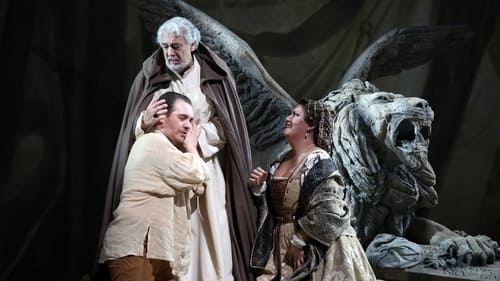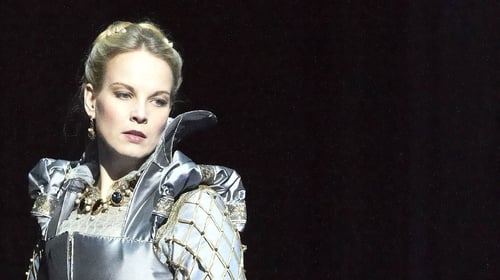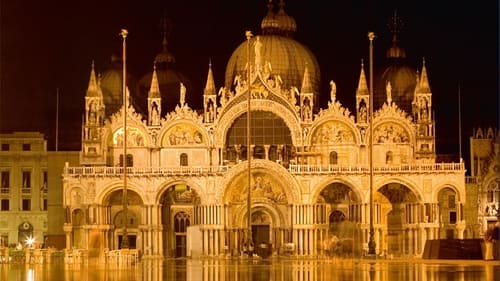
RADAMES
Love and duty collide and nations clash in Verdi's political drama, starring Elena Stikhina and Angel Blue and conducted by Antonio Pappano and Mark Elder.

Ernani is a love story about a young woman, Elvira, caught between three men: her lover, the nobleman-turned-outlaw Ernani; her guardian, the rich, elderly de Silva, who wants her for himself; and Don Carlo, the King of Spain who also has his eye on Elvira. Given the number of protagonists, it is also the story of a tragedy. Only 14 years after the premiere of Hernani, Giuseppe Verdi adapted Victor Hugo’s play into an opera to premiere at La Fenice, Venice in 1844. Ernani was an immediate and lasting triumph for the young Verdi, marking his prowess at adapting an historical event (the crowning of Charles V as emperor at Aachen Cathedral) to a psychologically convincing musical drama. The backdrop of three men paying court to one woman was the perfect foil for Verdi to explore the expressive qualities of three types of male voice. The tenor, the bass and the baritone.

Macduff

Riccardo

Cavaradossi

As Aragon descends into unrest, a count jealously fights for a noble lady's heart. But she has already given it to a passionate troubadour whose mother holds a terrible secret. This Verdi masterpiece overflows with dramatic tension and musical geniality, resulting in a story that increases in intensity throughout. Maria Agresta plays the unfortunate Leonora alongside Ludovic Tézier and Francesco Meli as her rival admirers in this new production at the Teatro Real.

Gabriele Adorno
Andrea De Rosa's production of Guiseppe Verdi's Liguria-set masterpiece about the eponymous 14th century Doge of Genoa. Ludovic Tezier is the Doge, Andriy Yurkevych conducts.

Carlo VII
"Giovanna d'Arco; ossia, la pulzella d'Orléans" is an operatic dramma lirico with a prologue and three acts by Giuseppe Verdi to an Italian libretto by Temistocle Solera. The opera partly reflects the story of Joan of Arc and is based on a play by Friedrich von Schiller, although claimed by the librettist to be "an entirely original Italian drama." If the thought of Anna Netrebko strutting her stuff in a suit of armour and tin hat sets your factor tingling then this is a must. It's an inconsistent opera but has some quite wonderful music along the way. The rest of the cast is good and the production won't offend either. Get it for Ms Netrebko's incredible performance alone.

Don José
담배공장에서 담뱃잎을 말아 생활하던 가난한 하층민 집시 여성 카르멘은 싸움에 말려 감옥에 갈 위기에 처하지만 군인 호세를 유혹하여 풀려난다. 다시 만난 호세와 카르멘은 사랑에 빠지게 되지만 몇 달 후 호세는 자신에게 싫증이 난 그녀의 마음이 투우사 에스카미요에게 있다는 것을 알게 되고 극단의 선택을 하기에 이른다.

Radamès

Jacopo Foscari
2016년 밀라노 라 스칼라 실황으로, LA오페라 총감독이자 현존 최고의 스타 성악가인 플라시도 도밍고가 정치적 음모에 의해 아들을 잃게 되는 고뇌에 찬 프란체스코 역을 맡았다. 그동안 도밍고와 함께 스페인 발렌시아, 데아터 안 데어 빈, 로열 오페라 등에서 호흡을 함께 해온 테너 프란체스코 멜리가 출연하여 두 사람의 안정된 호흡이 인상적이다. 소프라노 안나 피로치, 지휘자 미셸 마리오티의 합류는 상상 그 이상의 무대를 보여준다. 연출을 맡은 알비스 헤르마니스는 같은 해에 있었던 잘츠부르크 페스티벌에서 리하르트 슈트라우스의 후기작 ‘다나에의 사랑’을 올려 화제를 낳았던 인물. 이 작품이 2012년 9월 LA오페라에 오를 때부터 프란체스코 역을 전문적으로 맡아온 플라시도 도밍고의 명성과 열연은 스페인 발렌시아, 데아터 안 데어 빈, 로열 오페라 등으로 지속되는 동안에도 힘을 발휘했다. 이번 무대에서도 같은 역을 맡은 그의 존재로부터 눈을 떼려야 뗄 수 없다. 1막 3장 ‘오 나의 마음을 두드리는 옛 심정이여’부터 3막 2장 ‘운명의 종소리인가’로 이어지는 도밍고의 음성은 그의 전성기를 연상케 한다. 최고 지도자이면서도 정작 억울한 누명을 쓴 아들 자코포를 구출하지 못하는 프란체스코는 자신의 운명을 뼈저리게 느낀다. 15세기 베네치아 공국, 총독 프란체스코 포스카리의 아들 야코포는 살인 누명을 쓰고 크레타 섬에 유배되었다가 재판을 받기 위해 베네치아로 돌아온 상태이다. 야코포는 자신은 흉악한 음모의 희생자일 뿐이라고 말하며 그의 아내 루크레치아는 총독에게 자비를 구한다. 총독의 정적, 말리피에로가 이끄는 위원회는 총독의 사임을 요구하며 야코포에게는 유배를 명하는데...

Carlo VII
1845년 라 스칼라 극장에서 초연된 베르디의 일곱 번째 오페라로 독일의 문호 프리드리히 실러의 ‘오를레앙의 처녀’가 원작이며 테미스토클레 솔레라가 대본을 썼다. 오페라는 잔 다르크가 주인공이지만 실존인물에 대한 이야기보단 원작을 바탕으로 하고 있어 역사적 사실과 차이가 있다. 프랑스 역사상 가장 로맨틱한 이야기. 프랑스와 영국이 백년전쟁을 하던 시기, 프랑스군은 영국군에 밀려 프랑스 남부까지 후퇴에 이른다. 그 때 잔 다르크가 샤를 왕을 도와 프랑스를 위기에서 구해낸다. 샤를 왕과 잔 다르크는 서로에게 이끌리지만, 잔 다르크가 아버지 자코모에 의해 화형될 위기에 처한다.

Jacopo Foscari
2012년 9월 LA오페라를 시작으로 스페인 발렌시아, 데아터 안 데어 빈 등에서 공연된 최고의 프로덕션을 2015년 로열오페라의 무대를 통하여 만날 수 있다. LA오페라의 총감독이자 현존 최고의 스타 성악가인 플라시도 도밍고가 정치적 음모에 의해 아들을 잃게 되는 고뇌에 찬 프란체스코 역을 맡았다. 15세기 베네치아 공국, 총독 프란체스코 포스카리의 아들 야코포는 살인 누명을 쓰고 크레타 섬에 유배되었다가 재판을 받기 위해 베네치아로 돌아온 상태이다. 야코포는 자신은 흉악한 음모의 희생자일 뿐이라고 말하며 그의 아내 루크레치아는 총독에게 자비를 구한다. 총독의 정적, 말리피에로가 이끄는 위원회는 총독의 사임을 요구하며 야코포에게는 유배를 명한다. 하지만 유배지로 떠나는 배 안에서 야코포가 비밀리에 처형당했다는 비참한 소식이 들려 오고 총독은 자리에서 물러난다. 말리피에로가 새로운 총독으로 임명되었다는 소식을 듣자 프란체스코는 숨을 거둔다.

Manrico
The Count Di Luna believes that his younger brother was murdered years before by a vengeful gypsy but still hopes that he may be alive. When he attempts to court the beautiful Leonora, he is enraged to discover that she has a lover – the troubadour, Manrico. Manrico and the Count duel, and afterwards Manrico reveals to Azucena, the woman he believes to be his mother, that when he had the opportunity to kill the Count he felt something holding him back.

Riccardo

Himself
The recording took place in Teatro Farnese di Parma, a kind of "mini-Verona" stage, but under roof. Probably good acoustics. But that doesn't rescue this perfomance of the Requiem mass, the fault is mainly being the conductor's, Yuri Temirkanov. He doesn't at all seems inspired of this work and not interested in whats happens on stage, if judged by the video. Particularly, he seems unintersted in the choir. The tenor, Francesco Meli, delivers a very inspired Ingemisco, but the other soloists are probably affected by the conductor.

Recorded live from the Teatro Regio di Parma, 8 October 2011

Riccardo, Earl of Warwick and governor of Boston
Part of Tutto Verdi series - Un ballo in maschera (2011) Parma. Based on a Scribe libretto and begun as 'Gustavo III' set in Sweden, it became 'Una vendetta in dominò' set in Germany, and finally 'Un ballo', set not in Sweden but in Boston, Massachusetts during the colonial era. These changes were caused by a combination of censorship regulations in both Naples and Rome, as well as by the political situation in France in January 1858.

Lord Riccardo Percy
Gaetano Donizetti and his librettist Felice Romani kept the focus of their opera ANNA BOLENA on the personal rather than the political in this fictionalized Tudor tale: Henry VIII of England wants to get rid of his second wife, Anne Boleyn, so that he can marry her lady-in-waiting, Jane Seymour. He brings Lord Richard Percy, Anne's first love, back from exile so that he can find an excuse to accuse her of adultery. With the unwitting aid of Smeaton, a court musician, and Lord Rochefort, Anne's brother, the trap is easily sprung. This 2011 live recording from the Wiener Staatsoper showcases Anna Netrebko as she "scored a personal triumph" in her debut as the hapless Tudor Queen, while her stage partners - notably Elīna Garanča as Jane Seymour and Ildebrando D'Arcangelo as Henry VIII - were likewise showered with critical acclaim.

Gabriele Adorno
Part of Tutto Verdi series - Simon Boccanegra (2010) Parma. Revised version (1881). 'Simon Boccanegra' is an opera with a prologue and three acts by Giuseppe Verdi to an Italian libretto by Francesco Maria Piave, based on the play 'Simón Bocanegra' (1843) by Antonio García Gutiérrez, whose play 'El trovador' had been the basis for Verdi's 1853 opera, 'Il trovatore'. Simon Boccanegra was first performed at Teatro La Fenice in Venice on 12 March 1857

Two queens on one island. A recipe for disaster. Especially as both have a legitimate claim to the other's throne. They are, after all, related... So the power politics are the name of the game. And, for reasons of state, one of the heads that wears a crown has to roll. Maria Stuarda was laid to rest for more than a hundred years, finally being revived in 1958 in Bergamo under conductor Oliviero de Fabritiis. However the real breakthrough for the opera finally came with Giorgio de Lullo's Florentine production for the Maggio Musicale in 1967 (with set design and costumes by Pier Luigi Pizzi, director, set designer and costume designer at La Scala in 2008). As the two queens, Leyla Gencer and Shirley Verrett, set the vocal standards. Since then, the triumph of Maria Stuarda has been unstoppable.

Oronte
I Lombardi alla prima crociata (The Lombards on the First Crusade) was Verdi’s fourth opera and received its first performance at La Scala, Milan, in February 1843. The grandiloquent subject matter is fleshed-out with broad-brushed musical and dramatic effects and lavish choral scenes created a correspondingly impressive impact. A great success in Milan, it spread to the rest of Europe within a matter of only a few years.

Il conte d’Almaviva

Himself
The production itself is quite beautiful: recorded in the Basilica di San Marco in Venice in November 2007, it highlights the cathedral's splendor, the reverent audience, the soloists, orchestra and chorus with near-perfect cinematography. The soundtrack is also acceptable, which may have been quite a task to achieve, given the Basilica's over-reverberant acoustics. Alas, the performance itself does not rise to the occasion. Despite the occasional minor insecurity in ensemble and a visible lack of joy, the Symphonica Toscanini musicians play well, the Coro del Maggio Musicale Fiorentino members sing equally well, and the soloists are more than adequate, almost tangibly trying to excel.
















